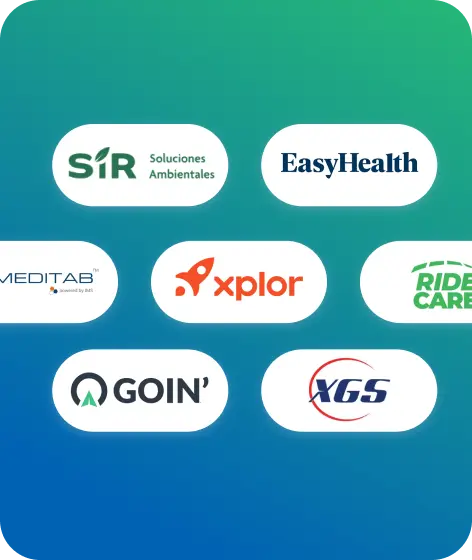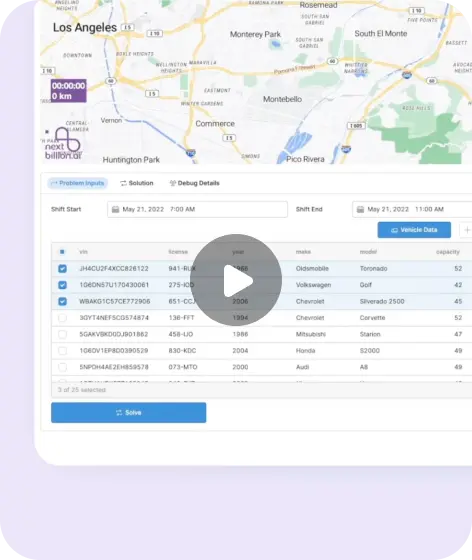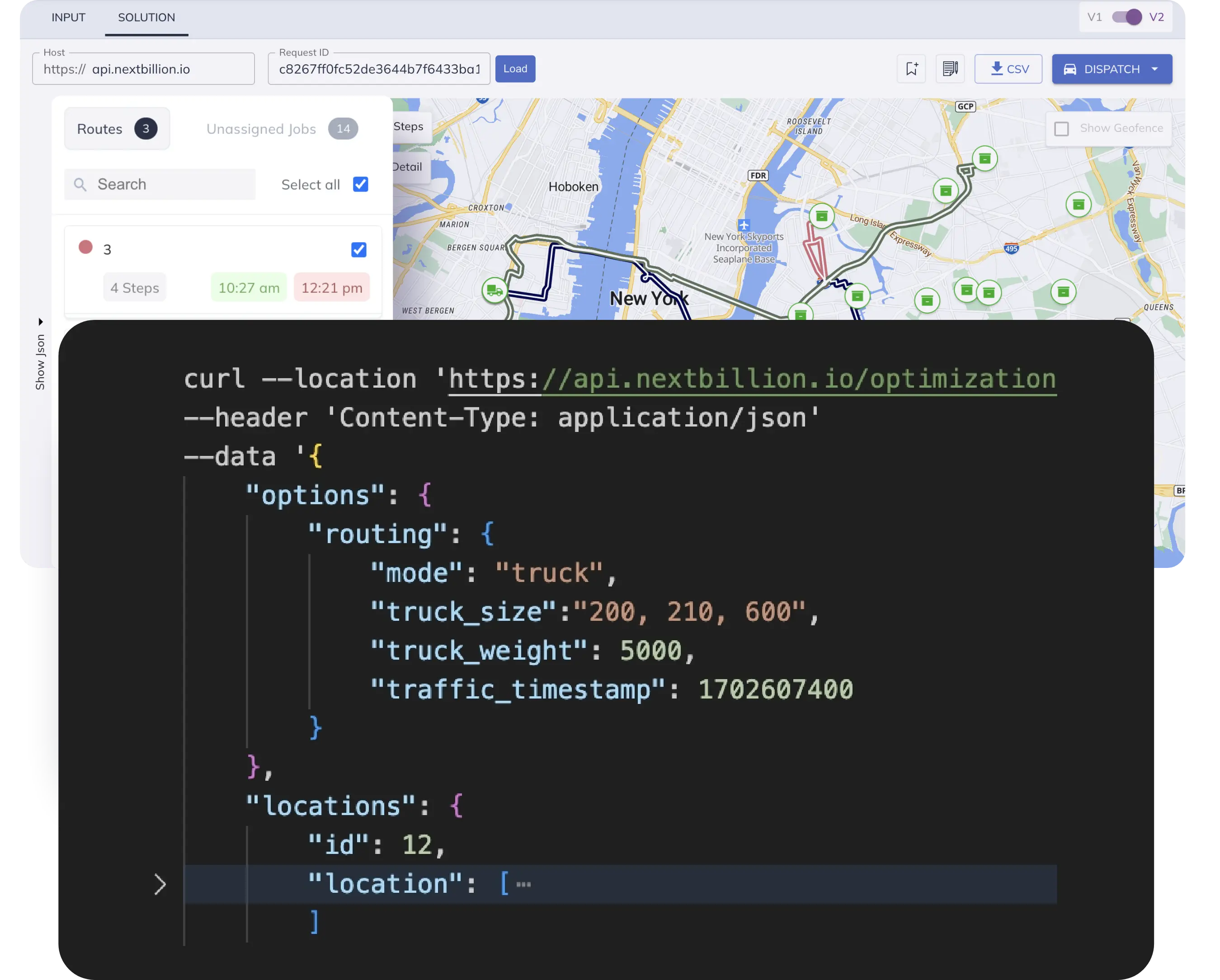Table of Contents
Early adopters loved the raw power of NextBillion.ai’s constraint-based routing APIs, but also flagged gaps such as sparse docs, small community, and a steep learning curve. Those critiques were fair then.
Today, the platform ships with thousands of pages of API reference, industry-specific tutorials, Postman collections, Observable notebooks, and an always-on solutions team. This article walks through exactly how the platform now removes friction for both solo developers and enterprise integration teams.
To begin with, here are a few myths listed.
Myth #1 – “The Documentation Is Lacking”
NextBillion.ai offers a rich set of self-serve resources to help developers integrate quickly and confidently, whether you’re solving a simple last-mile delivery problem or building a complex, constraint-heavy route optimization API.
The documentation includes comprehensive API references, step-by-step tutorials for industry-specific use cases (like NEMT, field service, waste collection and trucking), and ready-to-use Postman collections. Developers can explore interactive Observable notebooks for live demos, access integration walkthroughs via detailed YouTube videos, and leverage GitHub repos with sample payloads, sample apps, and playgrounds.
Whether you’re just getting started or scaling a production-grade system, these resources are built to shorten the learning curve and accelerate implementation.
| What Devs Asked For (2023) | What Exists in 2025 |
| Simple cURL examples | Interactive Playgrounds for every API |
| End-to-end demos | Industry playbooks (NEMT, field-service, last-mile) with sample payloads and demo videos |
| Postman collections | One-click collection updated with every API release |
| Visual explanations | Video tutorials + GIF snippets embedded inline |
| Hands-on experimentation | Observable notebooks that call live APIs |
Myth #2 – “The Ecosystem Is Too Small”
NextBillion.ai’s APIs and SDKs are actively used by top product and engineering teams across 30+ countries spanning the Americas, EMEA, and APAC. That breadth of real‑world usage means every release benefits from diverse production environments (infrastructure, data quality, regulations, and routing norms), which in turn surfaces edge cases quickly and helps the team iterate and ship fixes faster.
What global adoption translates to for you
- Broader edge‑case coverage: Country‑specific truck restrictions, regional addressing quirks, left/right‑hand driving norms, and local traffic behaviors get exercised in production and folded back into improvements.
- Faster, targeted fixes: Issues raised by experienced teams flow into a well‑defined triage process, with high‑impact bugs prioritized and patched rapidly often accompanied by examples and test cases contributed by customers.
- Higher integration confidence: The platform is validated against a wide variety of stacks (Node, Python, Java, Go; web and mobile clients; common message queues and data stores), reducing surprises during your own rollout.
- Better onboarding materials: Recurring patterns from global deployments become reference payloads, tutorials, and notebooks, so newcomers can start with proven templates.
A feedback loop built for engineers
- Transparent change logs & migration notes accompany releases; deprecations are signposted with guides and timelines.
- Public examples & reference apps reflect real deployment patterns for field service, NEMT, waste collection, trucking.
- Proactive solutions engineering closes the loop: when customers hit novel scenarios, the fixes often become documented recipes and reusable snippets for everyone.
Partner and community momentum
- A growing network of integration partners and SIs accelerates time‑to‑value with prebuilt connectors and blueprints.
- Office hours, webinars, and engineering posts distill lessons from multi‑region rollouts into practical guidance you can apply immediately.
Myth #3 – “Constraint-Based Routing Is Too Complex”
NextBillion.ai APIs are designed to abstract away the complexity of constraint-heavy routing, so your tech team can focus on solving real business problems, not building solvers from scratch. The APIs support a wide range of real-world logistics constraints such as time windows, vehicle capacities, order priorities, driver skills, rest breaks, and depot rules: all in a single, unified request.
This drastically reduces the need for pre-processing data or post-processing optimization results. You don’t have to stitch together multiple systems or maintain homegrown logic; just configure your constraints, hit the API, and get back fully optimized routes.
The best part? While the API is powerful, it’s not overwhelming because the documentation, tutorials, and support structure make it highly accessible. With clear examples, visual explainers, and hands-on notebooks, you’ll be able to understand and implement advanced routing logic within just a few hours.
If you have the right learning resources and someone to guide you through your use case, nothing is too complex. Many developers describe the experience as unlocking a “magic box” for solving routing problems they once thought were impossible.
Highlights:
- One API, many constraints: Handle time windows, capacities, skills, breaks, and more in a single request.
- Reduces engineering overhead: No custom solvers, no manual batching, no post-processing required.
- Purpose-built for tech teams: Declarative input, predictable outputs, and developer-friendly design.
- Scales with your use case: Start with 10 stops, grow to 10,000—all with the same API contract.
- Powerful docs + guidance: Observable notebooks, Postman kits, and hands-on support make ramp-up fast.
After just a few hours of exploring the documentation and example payloads, you will find yourself confidently solving routing problems that once took days, without writing a single line of optimization logic.
Hands On Technical Support
NextBillion.ai backs its powerful APIs with equally strong hands-on technical support. Whether you’re facing a unique routing challenge or need help structuring your API payloads, the solutions engineering team is highly responsive and deeply involved from onboarding to deployment.
They work closely with your developers to troubleshoot issues, fine-tune configurations, and even model custom constraints tailored to your business. It’s not just support, it’s expert partnership to help you build faster and smarter.
Even with gold-standard docs, sometimes you need a technical expert.
| Support Tier | Included Services |
| Starter | Email support, 1-business-day SLA, doc suggestions |
| Growth | Dedicated Slack channel, configuration review, quarterly reviews |
| Enterprise | Dedicated Solutions Architect, on-premise deployments, performance benchmarking, joint architecture whiteboard sessions |
The Solutions team commonly helps with:
- Translating messy CSVs or workflows into optimization-ready automation
- Custom constraint engineering (e.g., snow ploughing routes, fuel compartment mapping)
- Benchmarking vs. legacy optimizers
All Resources at a Glance
| Resource | Link / Location | What You’ll Find |
| Developer Docs | docs.nextbillion.ai | API reference with examples |
| Use Cases | https://nextbillion.ai/use-cases | Unique Use Cases with Notebooks |
| Video Demos | https://www.youtube.com/@NextBillionAI/videos | 3-min explainers videos |
| Industry Specific API Tutorials | https://docs.nextbillion.ai/solutions | API tutorials with industry specific problems |
| GitHub Samples | https://github.com/orgs/nextbillion-ai/repositories?type=all | SDKs, Sample Apps |
| Roadmap & Changelog | https://nextbillion.ai/blog/product-updates | Transparent progress |
Conclusion: From Myth to Momentum
If you evaluated NextBillion.ai in 2023 and bounced off the docs or thought the learning curve was too steep, it’s time for another look. The platform has grown significantly, not just in capabilities, but in usability. With clear documentation, ready-to-use examples, and tooling built for developers, it’s now easier than ever to get up and running. Whether you’re solving for five stops or five thousand, the focus is on reducing the friction between your problem and a working solution.
What sets it apart is the combination of technical depth and support. You get robust APIs that can handle real-world routing constraints without needing to build custom logic around it. And if you hit a roadblock, there are guides, sample projects, and real people ready to help. It’s not just about what the product can do, but how quickly and confidently you can make it work for your use case.
Frequently Asked Questions
Documentation & Learning Resources
- Is the NextBillion.ai documentation beginner-friendly for developers?
Yes. The documentation is structured with clarity in mind—starting from basic concepts and progressing into advanced use cases. Each API endpoint includes detailed parameter explanations, sample requests and responses, and real-world use case context, making it easy for developers of all levels to get started. - Are there examples or demos I can use to test the APIs quickly?
Absolutely. NextBillion.ai provides downloadable Postman collections, Observable notebooks with interactive payload testing, and sample JSONs tailored to common routing problems. These resources let you validate functionality without writing any integration code upfront.
- API Examples – https://docs.nextbillion.ai/optimization/route-optimization-api/tutorials
- Video Demos – https://www.youtube.com/playlist?list=PLZMAdC4T1ruggzmq-JK_fKR9EGk8n-m1v
- Is there a step-by-step guide for specific industries?
Yes. The platform offers industry-specific tutorials that walk you through how to structure API requests, set constraints, and interpret responses for different operational needs. These guides include payload samples and best practices tailored to each use case https://docs.nextbillion.ai/solutions and Video Demos. - Can I visualize how the routing API works before I integrate it?
Yes. Video demos and route planning visualizers let you see route optimization in action using sample inputs. There are also tools like the constraint builder and route replayer that help you understand how your inputs shape the final optimized route. - Where can I find live demos or examples?
You can get all these details here:
Docs: docs.nextbillion.ai
Industry Specific Example: docs.nextbillion.ai
Notebooks: nextbillion.ai/notebooks
YouTube: youtube.com/@NextBillionAI
Ecosystem & Adoption
- Is NextBillion.ai used by many developers or companies?
Yes. The platform is actively used by engineering teams in over 150+ businesses in 30 countries, including logistics startups, enterprise SaaS companies, and transportation providers. This broad usage validates the APIs in a wide range of environments and use cases. - Does a smaller ecosystem mean fewer updates or fixes?
No. In fact, global usage helps surface edge cases quickly, and those insights flow directly into the product roadmap. Fixes and improvements are pushed regularly, with transparent changelogs and proactive communication to affected customers. - Is it difficult to get help if I run into an integration issue?
Not at all. NextBillion.ai offers fast and hands-on technical support. Whether it’s a misunderstanding of a constraint or a payload formatting issue, the team works closely with you—often reviewing your exact input and guiding you to resolution. - Are there any SDKs or tools to help with integration?
Yes. You get exhaustive specifications for code generation, as well as prebuilt SDKs and example apps in Python, JavaScript, and other languages. There are also Postman collections and GitHub repos with CLI tools and payload builders.
Constraint-Based Routing Complexity
- Do I need to understand optimization algorithms to use the API?
No. You don’t need to build or understand the solver under the hood. You just need to describe your business constraints in a structured format (e.g., time windows or capacities), and the API handles the heavy lifting. - Can I start with a simple use case and scale later?
Yes. You can start with a basic stop sequence request and gradually add more advanced constraints over time. The API is flexible—so you grow at your pace without needing to rewrite everything when your use case expands. - What if I only need one or two constraints—do I still need to pass a large payload?
No. The API is modular. You only include the fields you need—if you’re only using time windows or priority, you can omit the rest. This makes it simple to implement even for lightweight use cases. - What kinds of constraints are supported in the same API call?
You can pass multiple real-world constraints in one API request, such as time windows, vehicle capacity, driver skills, depot rules, mandatory breaks, and stop-level priorities. The engine is designed to evaluate and balance all of them simultaneously. - How long does it take to understand and start using the constraints effectively?
Most developers are able to send constraint-rich optimization requests within a few hours. The tutorials, examples, and visual explainers help you grasp what each field does and how they influence the output—without needing a background in routing science. - Do I need to preprocess my data before using the NextBillion.ai APIs?
No heavy preprocessing is required. The API is designed to accept declarative inputs and return fully optimized routes, reducing your engineering overhead significantly.
Support & Troubleshooting
- Is there hands-on support available if we’re blocked during integration?
Yes. The solutions team is deeply involved in customer onboarding and ongoing integration. They review your setup, guide your payload modeling, and help you tune your configurations for performance, reliability, and cost-efficiency. - Can someone help us model a custom routing use case that doesn’t fit standard formats?
Definitely. Many customers come in with unique logistics workflows—fuel compartment routing, technician shift constraints, or hybrid vehicle fleets. The team works with you to break down the logic and model it using the available constraint fields.
Ready to get started?
Request a DemoTable of Contents





